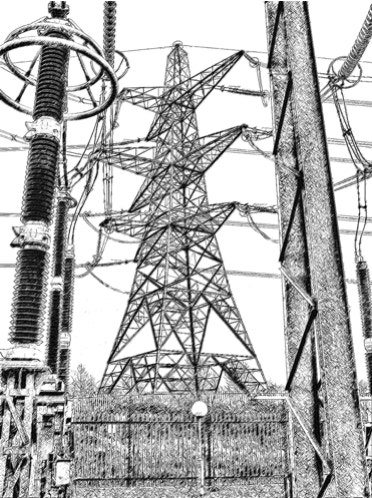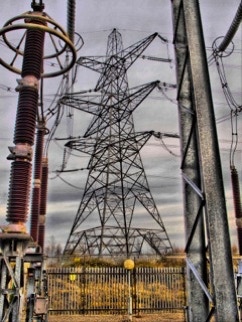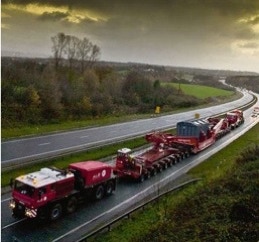

UKPN’s Proposal for a Substation
Is this really an appropriate addition to the north Essex landscape?
Stour Valley Underground say
no and over the next month or two will flesh out alternatives that are more environmentally acceptable and are economically sensible.
As part of our on-going mission to inform the communities affected by UKPN and National Grid’s proposals, we will also be holding another public meeting to provide you with a better understanding of what is proposed and to show you alternatives that you might prefer to see implemented.

The Proposals
On the 10th July 2012, UK Power Networks published their long awaited document outlining their need case and proposal for a substation in north Essex.
This article is intended to explain the key aspects of UKPN's proposals and provide some alternative options to such an unsightly and inappropriate addition to the beautiful countryside of north Essex border. We also look at evidence that the proposal is supported by skewed information and is developed to support a substation proposal that energy industrialists decided they wanted long before they looked at the wider options that are available. This article concludes with recommendations forsolutionsyou might like to support.
And to allow you to assess the validity of our case for more environmentally acceptable solutions and other statements we make in this article, we provide a link to their original need case and proposal documents. These are the outline UKPN document called Replacing the Powerline availablehere and the full UKPN need case and option report called 132kV Network Reconfiguration to Accommodate Wider Systems Works available here.
Is it possible for the public and SVU to come forward with better solutions?
Yes it is. Rather like National Grid's surveying and assessment of options and costs, UK Power Networks have come forward with a document which is built on inadequate desktop environmental surveys and inflated costs for options that they do not want adopted. This means thatfor all of us in the affected communities, ourbetter local knowledge together with the ability to develop realistic, better solutions provide us with plenty of scope to demonstrate that what UK Power Networks propose is inappropriate, damaging to the local economy and environment and simply the wrong solution.
Back to Basics: is a substation needed?
We had better start by explaining why UKPN say they need a substation in the first place.
In order to make the new power line that National Grid (NG) propose more environmentally acceptable, NG want to take over and replace the existing 132kv pylon linewith a new line of 50 metre tall pylons. The pylons they propose to replace are the smaller pylonsthat run west from Burstal Bridge near Ipswich to Twinstead and beyond. This line is one of two supply lines that power the Sudbury/Clare area via a distribution network facility known as Belchamp Substation. One line of pylons from Pelham in Hertfordshire currently provides the bulk of the power for this area while the line east from Ipswich is there to replace this source if problems arise on the line from Pelham.









UK Power Networks' Proposals
UKPN see the need for works in this area as an opportunity toreconfiguretheir distribution network. As we said above, at the moment the Sudbury area is supplied via Belchamp Substation from Pelham, to the west. In future they want to transfer the primary supply source to Bramford Substation near Ipswich to the east. This makes sense as Bramford is set to become one of the biggest substations in the country, supplied from Sizewell and the enormous windfarms just off our shores. So there is plenty of power available there.
UKPN's proposals are to install one, 180 ton 400kv to 132kv step down transformer near Twinstead along with all the other paraphernalia that comprises what is known as a Grid Supply Point (GSP) or substation. But there are clearly stated plans for anupgradeto two transformers in the medium term.So the substation, if built, will grow.
In order to see just what such a substation might look like, we have a gallery of pictures of the various parts on our websitehere.
Just getting the transformer to the site will be "an incredible journey" in the words of manufacturers ABB and you can read about the mammoth task of getting a supergrid transformer to a north London sitehere. There are also numerous videos on the internet showing the magnitude of the task of transporting supergrid transformers such asthisone. The more challenging task of delivering one to the Twinstead area would be a massively disruptive undertaking forcing reinforcement and modification of roads and bridges in the area.









A supergrid transformer on the road.
Imagine getting this through our lanes!
So what UKPN are proposing overall is:-
• building a huge single transformer substation in the Twinstead area
• reconfiguring the local distribution grid to have a substation at Twinstead supply the Sudbury / Clare area
• supplying the substation with power from Bramford via National Grid's existing 400kv line
• constructing a 1 transformer substation to make the cost seem low to get the choice of solution they want accepted on cost grounds and also to reduce the perceived environmental impact for planning consent purposes, then to expand to two transformers within the next decade.









…or put another way, something like this at Twinstead!
Foregone Conclusions and Foot in Mouth Disease
You will observe that we keep referring to the proposed site for the substation to benear Twinstead. These are indeed the words used by UKPN despite the fact that 3 sites between Twinstead and tother side of Castle Heddingham are supposedly under consideration. But we currently believe that we are again seeing consultation and option assessment that is designed (skewed) to deliver a pre-selected decision.
What evidence do we have for such a suggestion?
When National Grid first launched the consultation they called it the Bramford to Twinstead Overhead Line Project. They had already decided that an overhead line was what they wanted. Then they put forward 4 corridors but it was abundantly obvious that they wanted a corridor 2 decision because this option was more fully researched than any other and corridors 3 & 4 were utterly unconscionable choices put there to create the illusion of choice and consultation. The thinking that put the 400kv line beside the older 132kv line half a century ago still prevails in this industry. Not a lot by way of attitudes and methodologies seems to have changed in all that time.
The exploration of options for the siting of a substation has undergone a similar process.
The choices for a substation site are said to be:-
•
•
•
beside a visitor / tourist attraction in sight of a scheduled monument
in lovely countryside beside a listed building
beside a main road in a field sheltered by woodland
This last site has been more comprehensively surveyed than any other site and is the location nearest Twinstead.
Foot in Mouth disease is a disorder that is unusual to find in PR consultants. But National Grid have one who unwittingly told a Mail on Sunday columnist that NG could oversail her house with power lines if they chose! (NB: they cannot without her permission!) The consultant's reward was a page of negative publicity in a national paper. That was a year or so back and the PR consultant seems to have been having a particularly bad attack of Foot in Mouth back then as she also told a north Essex resident who's home is in the immediate vicinity of the prospective site nearest Twinstead that there would definitely be a substation and it would be built at the Twinstead site.
So over a year ago, National Grid had made their mind up which decision they were going to survey and stage manage the consult to support. And now, UKPN are playing the same game. They are massaging the figures to try to deliver the decision they want: the option they decided on a long while ago. Evidence for this is clear. The substation solution is being proposed at half its final form to reduce the supposed cost of this option. Then, using a technique that National Grid have demonstrated in the past, underground cable costs for the options we propose are exaggerated to make their chosen solution look like the only acceptable one on cost comparison grounds.
But all is not as it seems with other options that UKPN explore. This region's electricity supply system is being upgraded in any case and the existing substations (GSP's) will have more transformers added to them to deal with increasing future demand. So new transformers and other paraphernalia will be added to the GSPs no matter what solution is eventually selected to solve the local issue. And this means that UKPN should not really be including the cost of new transformers at existing sites in their calculations. This means that in fact a new two transformer substation at Twinstead is more costly than the Braintree to Rushley Green underground cable alternative that we proposed a while back.









Essex landscape as it can be after our solutions are installed!
Options
UKPN have looked at 8 options to replace the 132kv overhead line that National Grid want to take over. We need not go into detail on these but it might help you if we break them down into 4 groups for assessment. The option groups are:-
1.Replace the overhead line with another or with an underground cable: this works on a technical level and fits in with the UKPN wish to source the power for the Sudbury area from Bramford. SVU support the underground proposal.
2.Reinforce the UKPN owned local grid: This option reduces overall capacity and is less future proof and so SVU do not support it.
3.Reinforce Braintree Substation and run an underground cable up to Rushley Green to power Belchamp Substation. SVU support this proposal and did indeed put it forward in the first place. Braintree Substation will need upgrading no matter what and so the real cost for this solution is the cost of the underground cabling works which is less than that for a substation at Twinstead. It is an environmentally preferable solution and the fact that it takes longer to execute is not an issue because the existing 132kv overhead line can remain in place until the Braintree substation upgrade and cabling works are complete.
4.Build a new substation in the Essex countryside in either the beautiful Colne Valley or near historic Coggeshall or at the gateway to the painters landscapes that will one day form the extended Area of Outstanding Natural Beauty - Constable and Gainsborough country, near Twinstead. SVU reject all of these solutions as inappropriate for high value landscapes. We always oppose nimbyism and so reject the first two sites on that basis. SVU contend that blighting the entry point to a future AONB is a ridiculous idea.
And one more thing:and one more big ugly thing at that. According to UKPN, the Twinstead site is 1.5km away from the 132kv overhead line as it traverses the field beside the A131 looking toward Wickham St Paul. UKPN propose to connect the substation to this line via an underground cable. Underground cables are connected to overhead lines via a Sealing End Compound or SEC. This means that a sealing end compound is required in this field. A 132kv sealing end compound looks like this according to NG:-









So UKPN's proposal is for a vast ugly substation
similar to the earlier image in one field
with this unsightly contraption,
the other side of a lane in the next.
What options didn't UKPN properly explore?
Back in April, SVU proposed, at a Community Forum consultation meeting that UKPN explore the option of connecting their Belchamp Substation directly to Bramford Substation by underground cable, direct. At 35km, this is a longer cable run that the Burstal Bridge to Rushley Green one UKPN looked at but is a more secure solution that puts the primary supply to Belchamp and therefore Sudbury safely away from environmental, climatic or malevolent threat. The UKPN proposal still leaves only one pylon line from Rushley Green to Belchamp to carry the power for Sudbury. If this went down, the lights go out in Sudbury and district.
The members of the Twinstead Community Forum recall that UKPN agreed to look at this solution but UKPN say no and that they discounted the proposal early on because it would cost £60 million. That seems a huge figure when seen in the context of a currentproject in Walesfor a higher capacity 132kv underground cable system in more challenging terrain. The welsh project puts the cost for undergrounding at £1.34 million/km and therefore the cost for more capacity than is needed to supply Belchamp Substation over the distance we propose from Bramford would be less than£47 million and not £60 million as stated by UKPN. But then as we have said, we do expect such inflated costs for cables to support the option UKPN want.
What do SVU proposed solutions cost?
So the direct underground connection from Bramford to Belchamp is the most secure, environmentally acceptable solution. But at £47 million it costs more than our earlier proposal for an underground cable solution from Braintree Substation to Rushley Green as laid out on our websitehere. Thiswould cost £23 million based on UKPN routing and the welsh project's cost figures. We contend that an additional transformer at Braintree substation plus other equipment is required in any event to deal with increasing demand as identified in UKPN's document and is not therefore a cost specific to powering the cable solution we propose. £23 million puts this underground cable solution cost in very similar territory to UKPN's underspecified Twinstead substation option. The power source for the Braintree Substation is Bramford, via the proposed Bramford to Twinstead connection, Bramford being the source UKPN want to have provide the future supply for the Sudbury area. This therefore is the lowest cost environmentally acceptable solution that delivers the technical requirements identified by UKPN and is future proof, requiring no further expansion.
So, to sum up, UKPN have looked at only the options that suit their argument and proposed an underspecified substation to keep its apparent capital costs down while pricing out the solutions they do not want. Like all the best tricks, it only works well once before everyone subject to it wises up and sees it for what it is. And we have definitely seen this strategy before from UKPN's electricity industry colleagues at National Grid.
SOLUTIONS
So what proposals do SVU suggest that you consider supporting?
• NO new substation anywhere in north Essex
• Upgrade an existing National Grid substation (GSP) to provide a new supply for Belchamp Substation and the Sudbury area
• An underground cable connection from an existing National Grid GSP substation to UKPN's Belchamp Substation
or…
• SVU's economically sound underground cable from Braintree solution as described on our websitehere.
Going forward, SVU will provide fleshed out proposals in line with the above on this website. None of this is rocket science. The simple fact is that a new substation is not a necessary consequence of National Grid removing the existing 132kv overhead line. There are environmentally preferable solutions that are economically sensible and are in keeping with maintaining the beautiful, valuable landscapes of north Essex which will benefit the significantly important local tourism economy which has great potential for growth for generations to come.
National Grid will come forward with more consultation events in the months to come. Please attend one. SVU will also mount another informative meeting to bring you all the options you might prefer so that you are better able to respond to the consultation.
The key thing to remember from this article is this:-
A new substation is NOT a necessity -
there are better solutions that do not blight our countryside!
